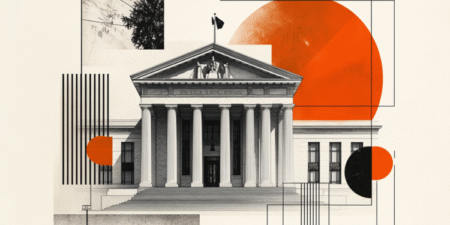- The Federal Reserve is expected to leave the policy rate unchanged for the fourth consecutive meeting.
- The revised Summary of Economic Projections, which includes the dot plot, could offer key clues about the policy outlook.
- The US Dollar could gather strength if policymakers project a single rate cut in 2025.
The United States (US) Federal Reserve (Fed) will announce monetary policy decisions and publish the revised Summary of Economic Projections (SEP), the so-called dot plot, following the June policy meeting on Wednesday.
Market participants widely anticipate the US central bank to leave policy settings unchanged for the fourth consecutive meeting, after cutting the interest rate by 25 basis points (bps) to the 4.25%-4.50% range in December.
The CME FedWatch Tool shows that investors virtually see no chance of a rate cut in June, while pricing in about a 15% probability of a 25 bps reduction in July.
The odds of the Fed opting for the first rate reduction of the year in September currently holds around 70%. Hence, revised projections in the dot plot and comments from Fed Chairman Jerome Powell in the post-meeting press conference could provide key hints on the timing and the number of rate cuts.
In March, the SEP showed that policymakers were projecting a total 50 bps reduction in the policy rate in 2025, while forecasting a 1.7% Gross Domestic Product (GDP) growth and a 2.8% core Personal Consumption Expenditures (PCE) inflation for the year.
Before the Fed went into the blackout period, several policymakers reiterated the need to remain patient and assess the economic developments before deciding on the next policy step.
Minneapolis Fed President Neel Kashkari said that the labour market is showing some signs of slowing down, but noted that the central bank must stay in wait-and-see mode to see how the economy responds to the uncertainty. Similarly, Philadelphia Fed President Patrick Harker noted that they still have no idea how shifting economic policies will affect the outlook and said that they need to wait while the economy faces many different possible paths.
Previewing the Fed’s May meeting, analysts at TD Securities said, “the FOMC is widely expected to keep rates unchanged for a fourth consecutive meeting next week. As uncertainty around the economic outlook remains elevated, we look for the FOMC to remain patient regarding its next policy decisions.”
“The revised SEP will likely show lower growth, higher unemployment, and higher inflation forecasts. We do not expect a shift in the median dots,” the analysts added.
When will the Fed announce its interest rate decision and how could it affect EUR/USD?
The US Federal Reserve is scheduled to announce its interest rate decision and publish the monetary policy statement, alongside the revised dot plot, on Wednesday at 18:00 GMT. This will be followed by Fed Chairman Jerome Powell’s press conference starting at 18:30 GMT.
In case the revised SEP shows that policymakers are still expecting a total of 50 bps reduction in interest rates this year, the USD could come under renewed selling pressure with the immediate reaction. A downward revision to GDP growth and/or inflation forecasts could intensify the USD sell-off.
Conversely, the USD could gather strength against its rivals if the dot plot highlights that officials now anticipate only one rate cut this year. Investors are currently pricing in about a 70% probability that the Fed will lower the policy rate at least twice in 2025. This market positioning suggests that the USD has a strong bullish potential in case of a hawkish surprise.
Chairman Powell’s comments could further influence the USD’s valuation. In case Powell adopts an optimistic tone about the inflation outlook and suggests that they could shift their focus to the labor market, the USD is likely to have a hard time outperforming its rivals. On the flip side, the currency could hold its ground if Powell reiterates the need for a patient stance, citing the heightened uncertainty surrounding the state of the economy in the near future.
Eren Sengezer, European Session Lead Analyst at FXStreet, provides a short-term technical outlook for EUR/USD:
“The near-term technical outlook suggests that the bullish bias remains intact, with the Relative Strength Index (RSI) indicator on the daily chart holding comfortably above 60. Additionally, EUR/USD trades well above the 20-day Simple Moving Average, currently located at 1.1420”
“On the downside, the mid-point of the four-month-old ascending regression channel forms the immediate resistance level at 1.1630. In case EUR/USD rises above this level and confirms it as support, it could face the next resistance at 1.1800 (static level, round level) before targeting 1.1900-1.1910 (round level, upper limit of the ascending channel). Looking south, support levels could be spotted at 1.1420 (20-day SMA), 1.1330 (50-day SMA, lower limit of the ascending channel) and 1.0980 (100-day SMA).”
US Dollar FAQs
The US Dollar (USD) is the official currency of the United States of America, and the ‘de facto’ currency of a significant number of other countries where it is found in circulation alongside local notes. It is the most heavily traded currency in the world, accounting for over 88% of all global foreign exchange turnover, or an average of $6.6 trillion in transactions per day, according to data from 2022.
Following the second world war, the USD took over from the British Pound as the world’s reserve currency. For most of its history, the US Dollar was backed by Gold, until the Bretton Woods Agreement in 1971 when the Gold Standard went away.
The most important single factor impacting on the value of the US Dollar is monetary policy, which is shaped by the Federal Reserve (Fed). The Fed has two mandates: to achieve price stability (control inflation) and foster full employment. Its primary tool to achieve these two goals is by adjusting interest rates.
When prices are rising too quickly and inflation is above the Fed’s 2% target, the Fed will raise rates, which helps the USD value. When inflation falls below 2% or the Unemployment Rate is too high, the Fed may lower interest rates, which weighs on the Greenback.
In extreme situations, the Federal Reserve can also print more Dollars and enact quantitative easing (QE). QE is the process by which the Fed substantially increases the flow of credit in a stuck financial system.
It is a non-standard policy measure used when credit has dried up because banks will not lend to each other (out of the fear of counterparty default). It is a last resort when simply lowering interest rates is unlikely to achieve the necessary result. It was the Fed’s weapon of choice to combat the credit crunch that occurred during the Great Financial Crisis in 2008. It involves the Fed printing more Dollars and using them to buy US government bonds predominantly from financial institutions. QE usually leads to a weaker US Dollar.
Quantitative tightening (QT) is the reverse process whereby the Federal Reserve stops buying bonds from financial institutions and does not reinvest the principal from the bonds it holds maturing in new purchases. It is usually positive for the US Dollar.
Read the full article here




